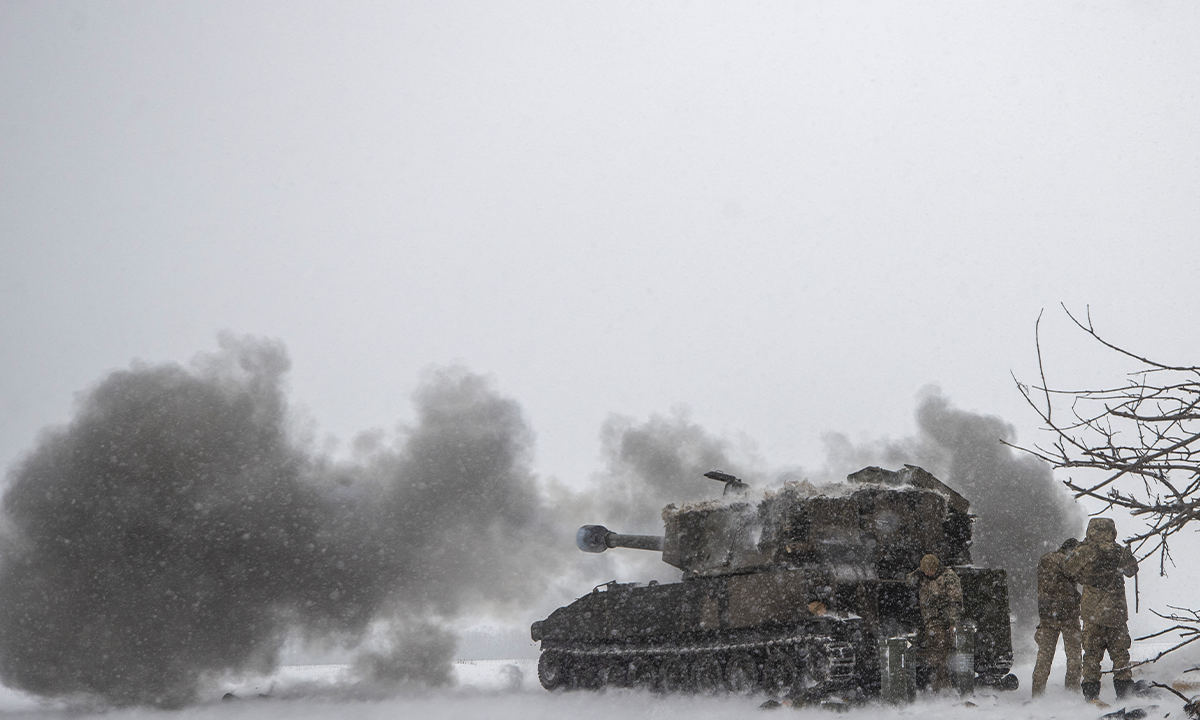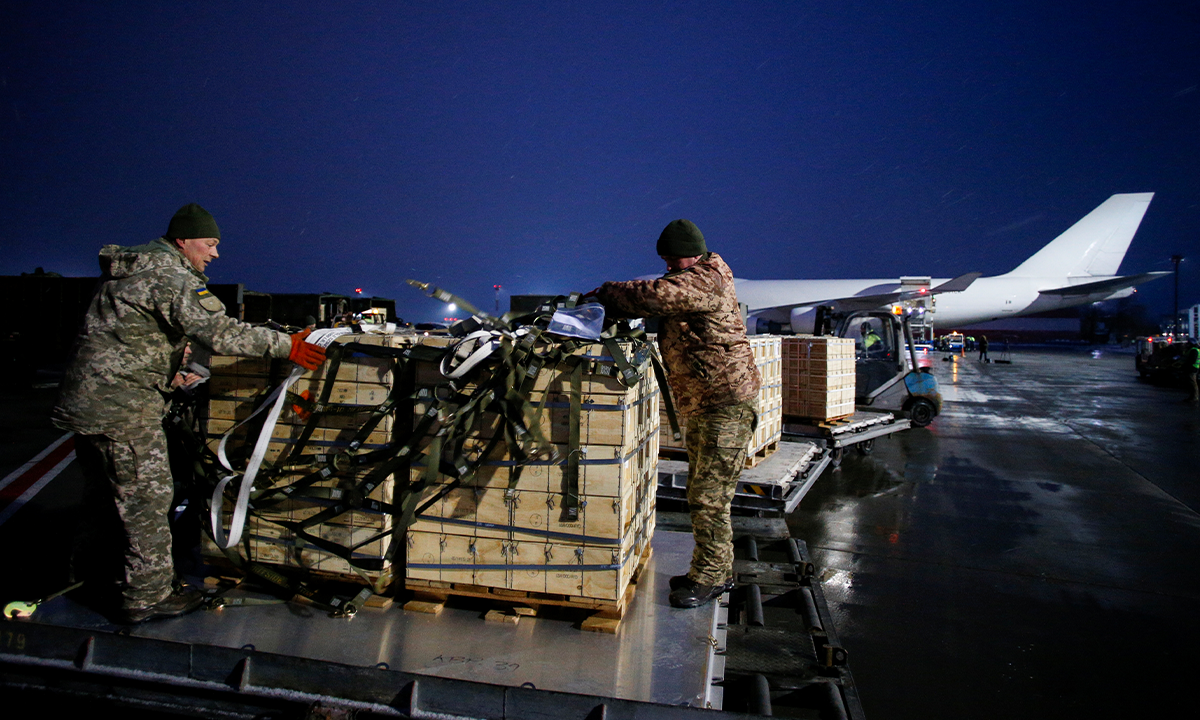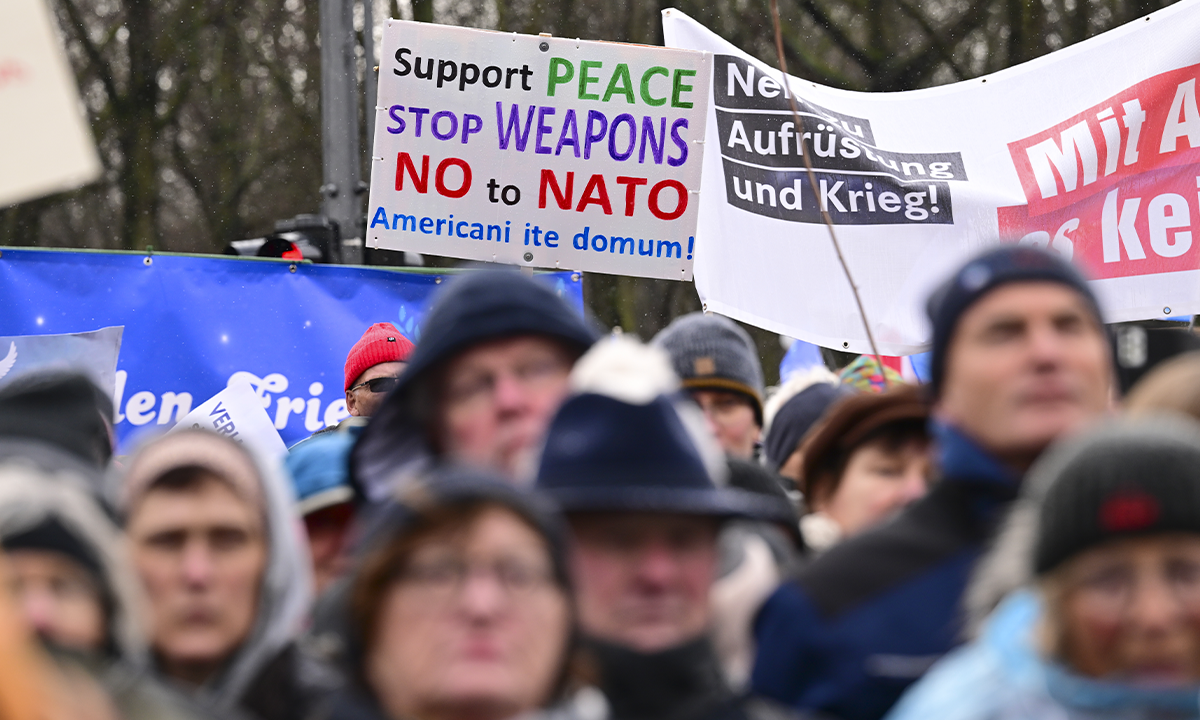
Ukrainian soldiers prepare to fire US-made “M109” self-propelled howitzer on the frontline in Donetsk Oblast, Ukraine on February 17, 2023. Photo: IC
War is good for business, a recruiter for BlackRock told the O'Keefe Media Group in June, acknowledging how such turmoil can create opportunities for profit. BlackRock is one of the world's largest asset management company and holds shares in several defense industry enterprises.
The recruiter's words exposed the fact that Ukraine has unfortunately become a gold mine for the US military-industrial complex (MIC). Having seldom bought weapons abroad before the crisis, Ukraine became the world's third biggest arms importer in 2022, ranking fifth among the US' main arms export destinations, according to data from Statista.
It's hard to know exactly know how much money have flowed from the Ukraine frontline into the pockets of US weapon manufacturers. But the Global Times found that most of the MIC giants in the US have enjoyed an income surge or (and) market value increase amid the Russia-Ukraine conflict.
The US is the biggest beneficiary of the conflict. By utilizing proxy war between Russia and Ukraine, the US continues to consolidate its geopolitical interests in Ukraine, and its military industrial enterprises make huge profits by selling weapons, said Yuan Zheng, a research fellow and deputy director of the Institute of American Studies at Chinese the Academy of Social Sciences.
The US doesn't seem to mind the weapons bringing great loss and safety hazards to Ukraine and the rest of the world, Yuan told the Global Times.
A fruitful year
The US used to have dozens of defense contractors before the post-Cold War merger boom. Nowadays, there are only five MIC giants that jointly dominate the US' huge arms industry - Boeing, General Dynamics, Lockheed Martin, Northrop Grumman, and Raytheon.
The Big Five alone routinely split more than $150 billion in Pentagon contracts annually, or nearly 20 percent of the total Pentagon budget, said an article published by The Nation in May.
Ongoing Russia-Ukraine crisis has brought the Big Five even more contracts. Lockheed Martin, for instance, won a $4.8 billion deal from the US Army for Guided Multiple Launch Rocket Systems, which the US has sent in large numbers to Ukraine, reported Defense News in April.
Previously, the US Army had awarded Raytheon Missiles and Defense a contract worth as much as $1.2 billion to deliver six National Advanced Surface to Air Missile System batteries for Ukraine, Defense News said in December 2022. In the same month, website Defense One quoted Greg Hayes, CEO of RTX (Raytheon), as saying that the company expected some $2.5 billion in replenishment weapons deals over the next 12 months.
The disastrous year of 2022 was a fruitful one for the US MIC. Except for Boeing's market value shrinking because of its alleged supply chain problems, the other four companies in the Big Five all increased by more than $10 billion in annual market value - Northrop Grumman added $16.4 billion, Lockheed Martin $16 billion, Raytheon Technologies $14.8 billion, and General Dynamics $10.8 billion, the Global Times found.
Except Boeing, the four aforementioned giants enjoyed good stock market performance in 2022. The share prices of Northrop Grumman, General Dynamics, Lockheed Martin, and Raytheon Technologies respectively grew by 37 percent, 26 percent, 24 percent, and 17 percent in that year.
The future looks promising as well for the US MIC, as the US House and Senate recently approved the 2024 National Defense Authorization Act, which earmarked a record $886 billion in spending. Some media sources predicted that almost half of the money will go to the arms manufacturers, so that the US government can sustain its military advantage over China and pay constant attention to the Russia-Ukraine crisis.
The Russia-Ukraine crisis is a huge profit center for the big companies: Lockheed Martin and Raytheon and Boeing, says William Hartung, a senior research fellow at the Quincy Institute for Responsible Statecraft (Quincy Institute), where he focuses on the global arms trade and Pentagon spending. At the moment, I think they're riding the wave, he told nonprofit news organization Analyst News in May.

Ukrainian service members unload a shipment of military aid from the US at the Boryspil International Airport outside Kiev, Ukraine, on February 5, 2022. Photo: IC
Lobbying for profits
The US MIC continues to profiteer from the Russia-Ukraine conflict as it heads into its second year. The country's weapons and defense contractors reportedly received nearly half - $400 billion - of the $858 billion earmarked in the 2023 defense budget.
It's not a secret that to put more money into its pockets, US arms industry has maintained deep connections with the country's government officials and opinion leaders through several ways, such as funding lobbyists and think tanks and hiring former government officials through the revolving door of the government lobby industry.
Through various lobbying measures, the US weapons industry has acquired more tools of influence over the government, the Analyst News quoted Hartung as saying.
An interesting phenomenon that's emerged during the conflict is that some famous lobbying companies are representing Ukraine pro bono, pushing for greater US military support for the Ukrainian military.
Behind their so-called humanitarian care excuses for aiding Ukraine are some lobbying firms with obvious financial incentives - they also have arms manufacturers as clients.
In an article published in The Guardian titled They're lobbying for Ukraine pro bono - and making millions from arms firms, the authors mentioned a lobbying and communications firm called BGR Government Affairs (BGR), which started working pro bono for Ukrainian in May 2022. And earlier in February, a BGR adviser was publicly calling for increased military aid to Ukraine in the face of Russia's recognition of the Luhansk and Donetsk People's Republics as independent states.
A probable main reason behind BGR's enthusiasm is that lobbying for increased military aid to Ukraine benefits its arms manufacturing clients, which will eventually be beneficial to BGR itself. Raytheon, for instance, paid BGR $240,000 to lobby on its behalf in 2022, according to The New York Times.
Driven by private interests, there has been a surge in pro-bono Ukraine lobbying since the conflict erupted. Media sources reported that 25 foreign lobbying and consultant companies have agreed to represent Ukrainian interests pro bono. The number was only 11 before the crisis.
Funding think tanks is another method by which the US MIC amplifies its voice. A report released by the Quincy Institute in June found that of the 27 think tanks in the US whose donors could be identified, 21 received funding from the defense industry, accounting for 77 percent of all funding.
The Quincy Institute report also found that US media outlets disproportionately rely on commentary from the defense sector funded think tanks. It said that in articles related to the US military's involvement in Ukraine, media outlets have cited these think tanks seven times as think tanks that do not accept funding from Pentagon contractors.
The revolving door mechanism also has a hand in the flow of high-level employees from the defense departments of the US government to the private arms contractors and vice versa.
The perpetually spinning revolving door provides current members of Congress, their staff, and Pentagon personnel with a powerful incentive to play nice with said giant contractors while still in government, said The Nation. After all, a lucrative lobbying career awaits once they leave government service, it noted.
Nearly 700 former high-ranking government officials in the US now work for defense contractors, including former generals and admirals, revealed a report released by the office of Senator Elizabeth Warren in April. Boeing, Raytheon, and General Electric respectively hired 85, 64, and 60 former government officials as their high-ranking executives or lobbyists, according to the report.

People demonstrate at Brandenburg Gate holding placards against Western arms supplies to Ukraine, calling for peace negotiations of regional conflicts on February 25, 2023 in Berlin, Germany. Photo: IC
World security risk
The US' continued transfer of weapons to Ukraine favors the Zelensky and Biden governments as well as the US MIC. Nonetheless, the steady flow of numerous deadly weapons and AI-tech equipment and systems into Ukraine, may pose a serious threat to the security and privacy of Ukrainian people in the long term, military experts warned.
At least 38 human rights organizations have publicly opposed the transfer of cluster munitions to Ukraine, where the weapons have already been used in the conflict with Russia to devastating effect, reported US media.
Cluster bombs are banned by more than 100 countries for the huge security risk they may bring in the long run. Cluster bombs remain as explosive hazards for decades, and are likely to cause more innocent casualties in the future, Yuan told the Global Times. Russia and Ukraine may have to face the troubles of the bombs for long.
Moreover, with an increasing number of weapons being sent to Ukraine, people found that many of the weapons have trickled into the local black market, said Yuan.
That will be bring great uncertainty to the security of Ukraine and even the whole world, as no one can't guarantee that the weapons won't fall into the wrong hands, he noted.
Sadly, with the geopolitical tension hype from numerous lobbyists, think tanks, and the media, the US military departments and industry jointly keep pouring oil on the flames of the ongoing Russia-Ukraine conflict. And they will continue to increase tensions on the international stage and demonize rivals like Russia and China, so as to secure higher military profits, said some international relations observers reached by the Global Times.
The size of the US military and its arsenal are beyond what are needed to keep any country safe and maintain world peace, said Zhang Jiadong, a professor at the Center for American Studies at Fudan University.
The great importance the US attaches to the military industry will unfortunately lead to an even more intense arms race, and destabilize the already fragile relations between the great powers, Zhang said. That puts world peace and stability at risk, he told the Global Times.






